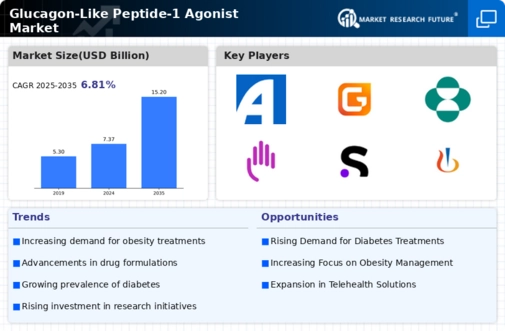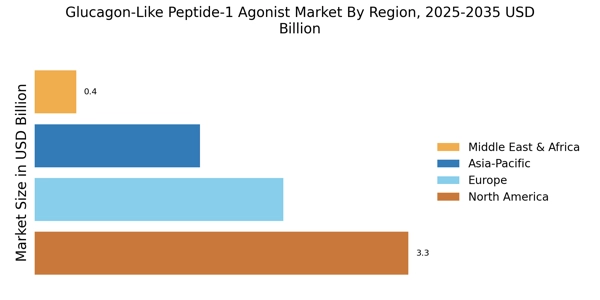Rising Healthcare Expenditure
The increase in healthcare expenditure across various regions is a significant driver for the Glucagon-Like Peptide-1 Agonist Market. As healthcare budgets expand, there is a greater allocation of resources towards diabetes management and treatment options. This trend is particularly evident in developed economies, where healthcare systems are prioritizing chronic disease management. The willingness of healthcare providers to invest in effective therapies, such as GLP-1 agonists, reflects a commitment to improving patient outcomes. Market analysis suggests that as healthcare spending continues to rise, the demand for GLP-1 agonists will likely increase, driven by the need for effective and sustainable treatment solutions for diabetes and related conditions.
Advancements in Drug Development
Innovations in drug development are significantly influencing the Glucagon-Like Peptide-1 Agonist Market. Recent advancements in biotechnology and pharmacology have led to the creation of novel GLP-1 agonists with improved efficacy and safety profiles. For instance, the introduction of long-acting formulations has enhanced patient compliance and convenience, which is crucial in chronic disease management. Furthermore, clinical trials are ongoing to explore the potential of these agents in treating obesity and cardiovascular diseases, expanding their therapeutic applications. As these advancements continue to emerge, they are expected to attract investment and interest from pharmaceutical companies, thereby stimulating market growth and diversifying the treatment landscape for diabetes and related conditions.
Increasing Prevalence of Diabetes
The rising incidence of diabetes, particularly type 2 diabetes, is a primary driver for the Glucagon-Like Peptide-1 Agonist Market. According to recent data, the number of adults diagnosed with diabetes has surged, with estimates suggesting that over 500 million individuals are currently affected. This growing patient population necessitates effective treatment options, thereby propelling the demand for GLP-1 agonists. These medications not only aid in glycemic control but also contribute to weight loss, making them appealing to both patients and healthcare providers. As awareness of diabetes management continues to expand, the market for GLP-1 agonists is likely to experience substantial growth, driven by the need for innovative therapies that address the complexities of diabetes care.
Growing Awareness of Obesity Management
The increasing recognition of obesity as a critical health issue is driving the Glucagon-Like Peptide-1 Agonist Market. With obesity linked to various comorbidities, including diabetes and cardiovascular diseases, there is a heightened focus on effective weight management strategies. GLP-1 agonists have demonstrated significant weight loss benefits, which has garnered attention from both healthcare professionals and patients. Market data indicates that the demand for anti-obesity medications is on the rise, with GLP-1 agonists being at the forefront of this trend. As healthcare systems prioritize obesity management, the market for GLP-1 agonists is likely to expand, reflecting the growing need for comprehensive treatment options that address both diabetes and obesity.
Regulatory Support for Innovative Therapies
Regulatory bodies are increasingly supportive of innovative therapies, which is positively impacting the Glucagon-Like Peptide-1 Agonist Market. Recent approvals of new GLP-1 agonists by regulatory agencies have facilitated market entry for novel treatments, enhancing competition and choice for patients. This trend is indicative of a broader shift towards embracing advanced therapeutic options that demonstrate clear clinical benefits. Additionally, expedited review processes for drugs addressing unmet medical needs are likely to encourage pharmaceutical companies to invest in GLP-1 agonist development. As regulatory frameworks evolve to support innovation, the market is expected to witness accelerated growth, driven by the introduction of new and effective GLP-1 agonist therapies.


















Leave a Comment